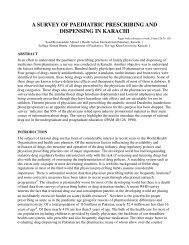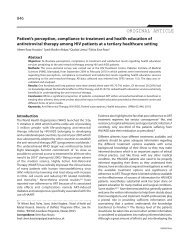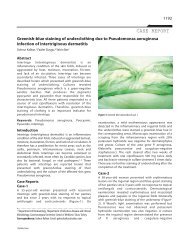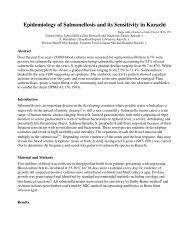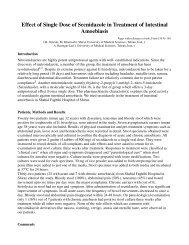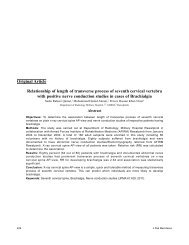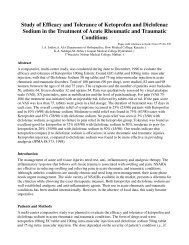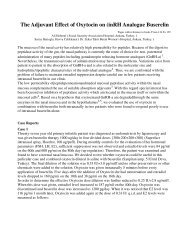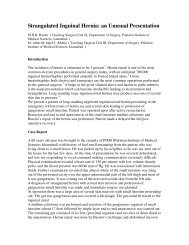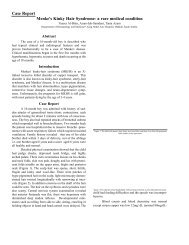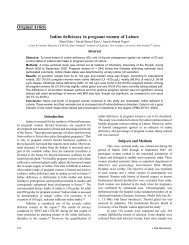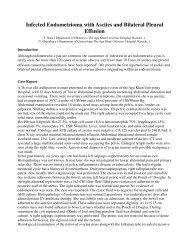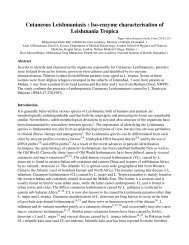Midazolam and thiopentone co-induction - ResearchGate
Midazolam and thiopentone co-induction - ResearchGate
Midazolam and thiopentone co-induction - ResearchGate
Create successful ePaper yourself
Turn your PDF publications into a flip-book with our unique Google optimized e-Paper software.
different between the three groups.<br />
Bradycardia: Non of the patients in group B developed<br />
bradycardia as <strong>co</strong>mpared to four patients in group A <strong>and</strong> one<br />
in group B. The difference among the groups was not<br />
statistically significant.<br />
Tachycardia: Five patients in group A, eight in group B<br />
<strong>and</strong> eight in group C developed tachycardia. This difference<br />
was not statistically significant.<br />
Hypotension: Four patients in group A, three in group B<br />
<strong>and</strong> three in group C developed hypotension.<br />
Hypertension: Two patients in group A, four in group B<br />
<strong>and</strong> seven in group C developed hypertension. The<br />
difference was not statistically significant.<br />
Pain on injection: Three patients in group A, one in group<br />
B <strong>and</strong> non in group C <strong>co</strong>mplained of pain on injection.<br />
Arrythmias: No patient developed arrhythmia in either<br />
group.<br />
Hiccups: Only one patient in group B developed hiccups.<br />
Hypersensitivity reactions: No patient in any group<br />
developed a hypersensitivity reaction.<br />
Discussion<br />
Thiopentone is the most <strong>co</strong>mmonly used anaesthesia<br />
<strong>induction</strong> agent in Pakistan. It has been the 'gold st<strong>and</strong>ard'<br />
for <strong>induction</strong> of anaesthesia. Side effects are apnea,<br />
hypotension <strong>and</strong> adverse sequelae associated with<br />
accidental extra vascular injection. 11,12<br />
One of the fundamental features of good quality<br />
anaesthesia is amnesia i.e., patient should be <strong>co</strong>mpletely<br />
unaware of the events during surgery. The incidence of<br />
awareness in non-obstetrical <strong>and</strong> non-cardiac surgical cases<br />
is reported to be 0.2%. A higher incidence has been reported<br />
in cardiac surgery (1.1-1.5%), obstetric surgery (0.4%) <strong>and</strong><br />
major trauma cases (11-41%). 13 Perioperative awareness<br />
may cause anxiety, pain, panic <strong>and</strong> hemodynamic<br />
instability (e.g. rise in heart rate <strong>and</strong> blood pressure), while<br />
its postoperative sequelae may lead to post traumatic stress<br />
disorder including repetitive night mares, anxiety <strong>and</strong><br />
irritability, a preoccupation with death <strong>and</strong> <strong>co</strong>ncern with<br />
sanity.<br />
Light anaesthesia is claimed to be the major factor<br />
responsible for awareness. In cardiac surgery <strong>and</strong> major<br />
trauma cases hemodynamic instability is the major <strong>co</strong>ncern<br />
at <strong>induction</strong> of anaesthesia. Fall in blood pressure associated<br />
with administration of <strong>thiopentone</strong> can aggravate this<br />
untoward effect. The dose of <strong>thiopentone</strong> is therefore<br />
reduced to avoid hypotension. Reduction of the dose of<br />
<strong>thiopentone</strong> may lead to awareness. Loss of verbal <strong>co</strong>ntact<br />
<strong>and</strong> loss of eyelash reflex has been taken as the endpoint of<br />
545<br />
hypnosis by most of anaesthetists <strong>and</strong> the dose of<br />
<strong>thiopentone</strong> is titrated to achieve this end point. However<br />
observation of voluntary movements or movement response<br />
to noxious stimuli is the best clinical measure available for<br />
detecting wakefulness or impending wakefulness. 13<br />
Premedication with amnesic drugs e.g., midazolam is<br />
re<strong>co</strong>mmended as one of the techniques to prevent<br />
awareness.<br />
<strong>Midazolam</strong>, a water-soluble benzodiazepine is used<br />
as an intravenous <strong>induction</strong> agent in a dose of 0.125 to 0.2<br />
mg.kg-1. Side effects include apnea, mild burning sensation<br />
at the injection site <strong>and</strong> slight decrease in systolic blood<br />
pressure. Advantages include short duration of action <strong>and</strong><br />
cardiovascular stability. 14,15 The sedative <strong>and</strong> hypnotic<br />
effects of barbiturates <strong>and</strong> benzodiazepines are mediated<br />
through separate receptors within the Gama amino-butyric<br />
acid (GABA) supra-molecular <strong>co</strong>mplex. 1 When used in<br />
<strong>co</strong>mbination, a synergistic interaction has been found<br />
between the two. 3,4,6,15 Barbiturates allosterically enhance<br />
benzodiazepine binding to the benzodiazepine receptors. 6<br />
This interaction is mutual i.e., <strong>thiopentone</strong> potentiates the<br />
effect of midazolam <strong>and</strong> midazolam potentiates<br />
<strong>thiopentone</strong>.<br />
Several authors have studied <strong>co</strong>-<strong>induction</strong> of<br />
anaesthesia with <strong>thiopentone</strong> <strong>and</strong> midazolam. 6,12,16 Some of<br />
the previous studies have shown that a low sub-hypnotic<br />
dose of midazolam (0.02 mg.kg-1) reduces the <strong>induction</strong><br />
dose of <strong>thiopentone</strong> by 50%. 1,4,6 These studies took the<br />
onset of hypnosis as the only end point of <strong>induction</strong>. In our<br />
present study, we evaluated <strong>co</strong>-<strong>induction</strong> with <strong>thiopentone</strong><br />
<strong>and</strong> midazolam <strong>co</strong>mbination <strong>and</strong> studied three different end<br />
points. In addition to loss of verbal response <strong>and</strong> loss of<br />
eyelash reflex, a tetanic stimulus of 50 Hz was also applied<br />
for 5 se<strong>co</strong>nds over the ulnar nerve in forearm.Tetanic<br />
stimulation is <strong>co</strong>nsidered equivalent to a painful stimulus9,11 <strong>and</strong> has not been <strong>co</strong>nsidered an end point of <strong>induction</strong> in<br />
other studies.<br />
Our results showed that, patients in group B i.e.<br />
midazolam 0.02 mg.kg-1 followed by <strong>thiopentone</strong> 3 mg.<br />
kg-1 were found to achieve hypnosis in significantly shorter<br />
time (p



